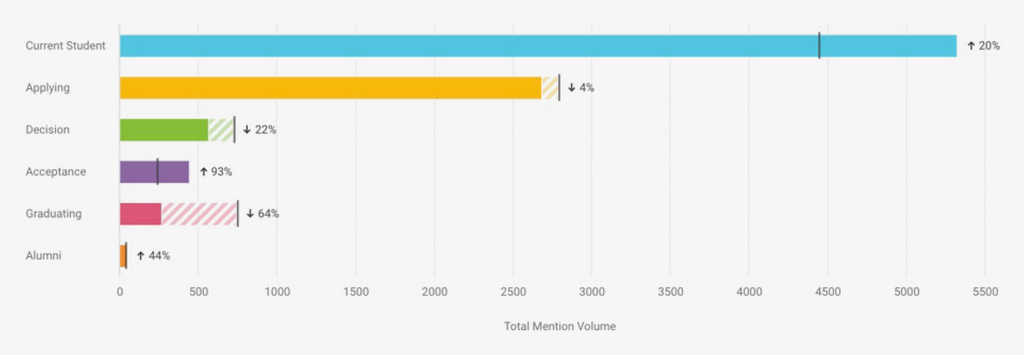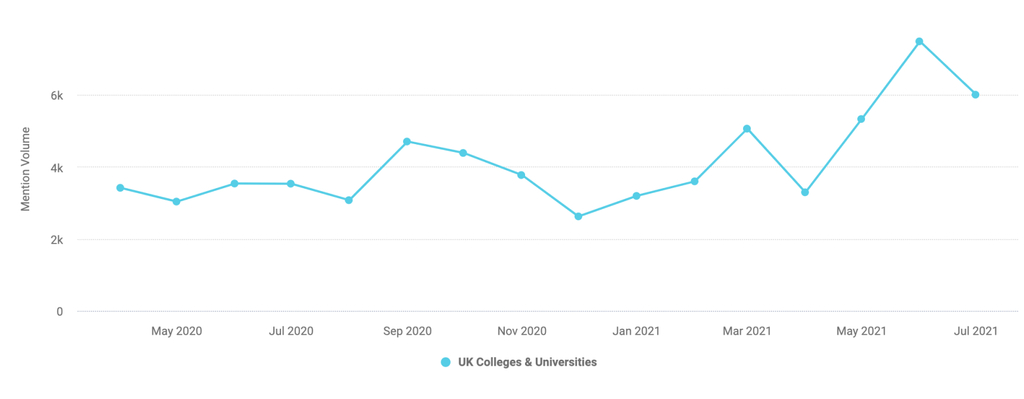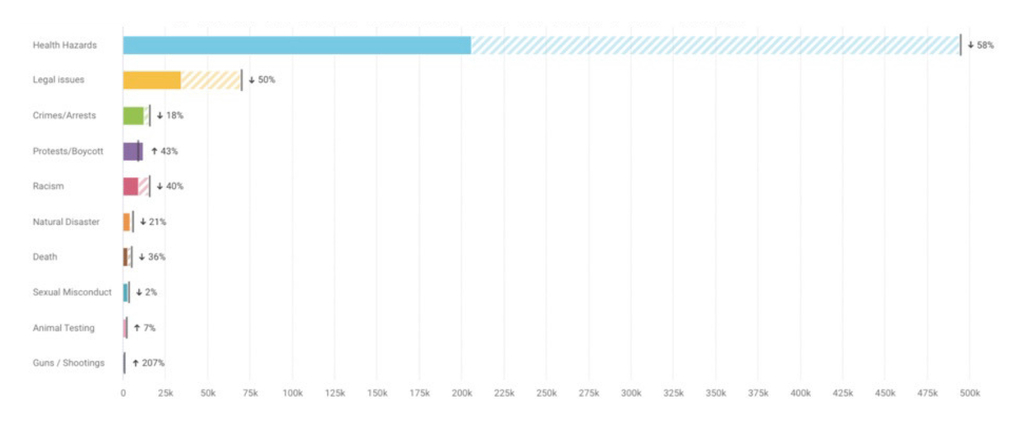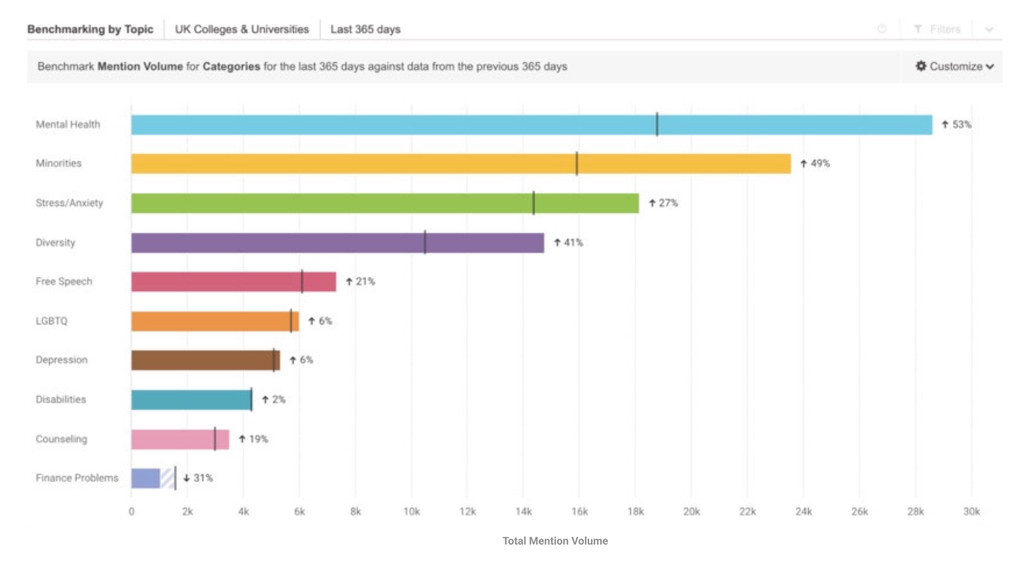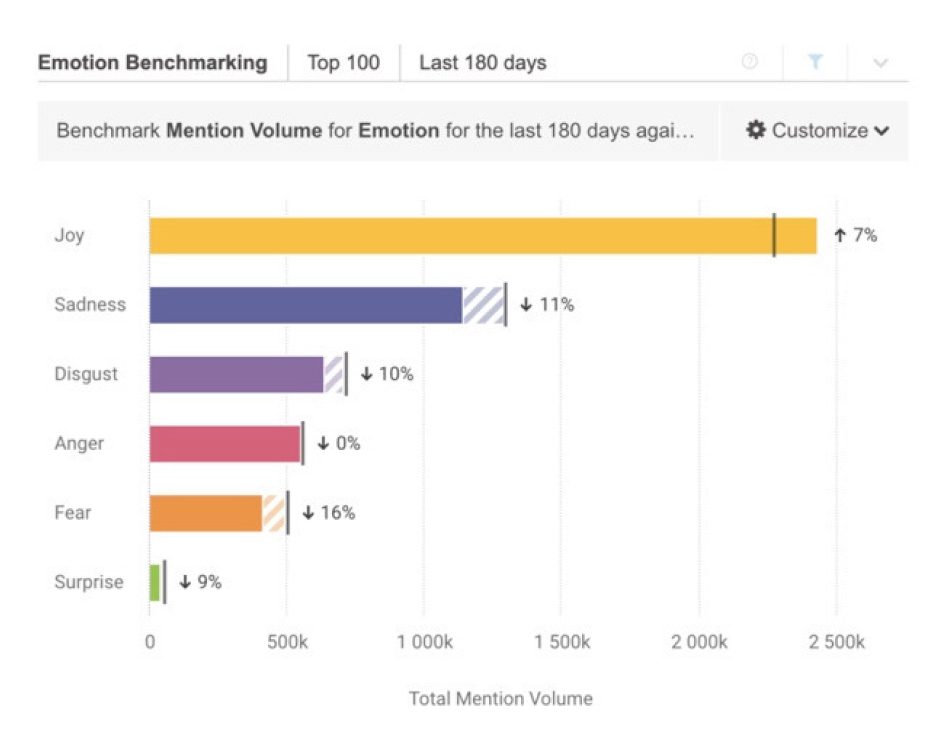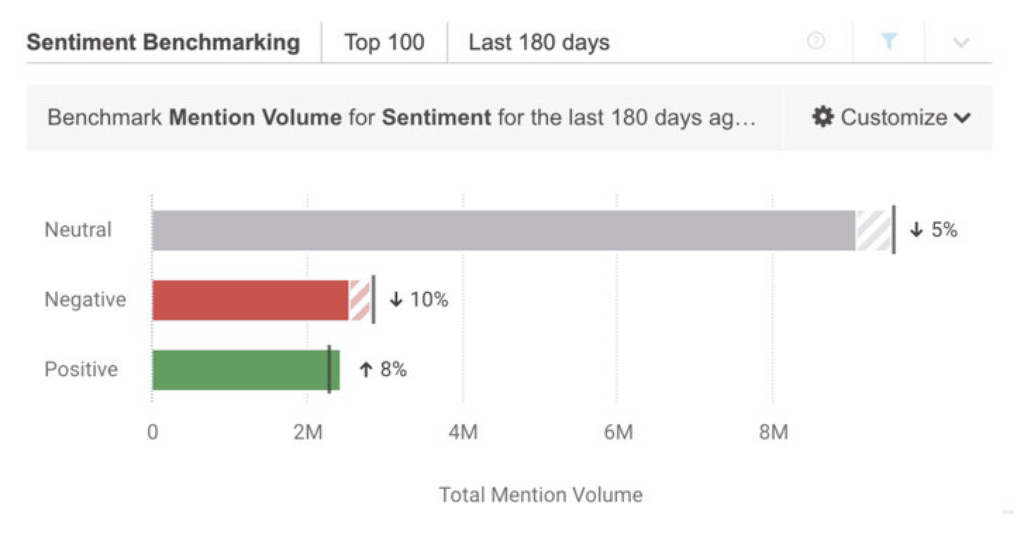REPORT
The State of the Higher Education Social Media Marketing Profession in 2021
Discover what’s trending in social media marketing in higher education and learn about the tools and strategies that'll set you up for success.
See Brandwatch for Education in actionThe higher education landscape for marketers has changed dramatically over the last year. Engagement rates for nearly every university have increased, new platforms have emerged, and conversations have moved on from pandemic fears to admissions questions.
In this guide, you'll hear from 40 individuals who each work in social media at universities in the UK. We'll be sharing survey results as well as in-depth interviews with professionals in the field. We’ll reveal surprising engagement insights, dive into discussion topics, and explore key challenges social media marketers face, and the support they need. What does it mean to be a social media marketing professional in 2021? Read on to find out.
Who are key higher education social media target audiences?
We’ll look first at the audience groups universities target most often with social media content and campaigns.
According to our online survey, for the vast majority of institutions, prospective students are the most frequently targeted primary audience for higher education social media professionals.
We used Brandwatch to analyze the conversation around higher education in the UK. On a closer look at the student audience, we see that current students are driving the conversation online. Graduating student discussions have declined significantly, whilst alumni conversations have increased.
However, surprisingly, the most engaged social media audience is scientists, researchers, teachers, and lecturers – higher than students!


We asked our survey participants which audiences they consider primary, secondary, and tertiary audiences. Researchers and academics are considered a primary or secondary audience by the most established universities.
For Russell Group’s The University of Manchester, researchers are a primary audience. Alistair Beech, Senior Social Media Coordinator explains, “one key audience for us is external academics. People working in higher senior levels across the world who we showcase our world-leading research to through campaign activity.”
Younger universities consider them differently with 40% of 1994 Group universities, 44% of New Universities, and 70% of University of London Colleges categorising them as a tertiary audience.
Despite Brandwatch revealing academics and researchers to be the most vocal audience, fewer than half (40%) of social media professionals consider them a very important audience to work with.
The only group to entirely agree that researchers and academics are an extremely important or very important audience are Ancient Universities.
38% of social media professionals told us that it has been difficult to work with academics and researchers over the past 12 months.
The second most frequently targeted audience are current students, with 70% of survey participants naming them as a primary target group.
Over 50% of those surveyed reported that parents, guardians, and influencers are the most frequently targeted secondary audience.
How has engagement been affected over the last year?
Engagement is a key metric for social media professionals.
Generally, high engagement (comments and shares) is considered an important social media objective by the majority of participants’ universities. Answering questions quickly was rated the most important objective.
Hard metrics are not the only measure of engagement for higher education professionals. Emma Gilmartin, Head of Social Media and Student Communications at the University of Glasgow says, “we do look at engagement metrics, but we also see where our messages have landed using anecdotal reports.”
Engagement rates have increased for many universities over the past 12 months. As Cat Prill, Marketing Coordinator (Campaigns) at Lancaster University explains, “there’s certainly been an increase in people really engaging with the content that we're producing.”
Brandwatch analysis corroborated this finding, with an 11% increase in engagement in social media posts in the last six months.
Although people are posting less about higher education generally compared to the start of 2021, they are engaging with other people’s content about higher education more.
The University of Liverpool, for example, has received over double the engagement this year compared to last.
Which channels do higher education social media professionals use?
Higher education social media professionals manage multiple channels. Across all universities, Instagram is allocated the most time and budget resource, equal to or closely followed by Twitter.
Mollie Footitt, Social Media Officer at the University of Leicester explains, “Instagram is where our students are and that's where our engagement rate is the highest.”
Our interviewees explained that Twitter is an important platform. Emma says, “a lot of stakeholders are on Twitter.”
Although students and stakeholders are a key audience on TikTok for some higher education social media teams, it’s temporarily taken a back seat. But as the pandemic restrictions lift, TikTok will likely take more of a leading role.
Emma explains, “we had just launched our account on TikTok, and it was doing really well, but then COVID-19 hit and we had to put the brakes on. We’ve got great ideas and we could be doing much more, but as we can’t get on campus, we can’t create that great content at the moment.”
The University of Leicester has incorporated TikTok content into recent campaigns. Mollie says, “we’ve had quite a lot of fun over the past few weeks putting out quite a few city-based TikToks and they’ve done really well.”
Paid advertising serves Lancaster University well, as Cat explains, “we've had real success with our ads on TikTok and this is being reflected in our budget. We get more ‘bang for our buck’ on TikTok compared to other platforms such as Facebook and Instagram.”
TikTok videos also play well organically on other platforms, Alistair explains, “posting our TikTok content on Instagram has certainly impacted our follower count, it really gives it a boost.”
Facebook and LinkedIn tend to see lower engagement rates, but Emma says, “LinkedIn is good for rankings content, highbrow research and senior role appointments.”
For Lancaster University, Cat says, “LinkedIn is used almost solely for our alumni and business contacts.”
What resources do higher education social media teams have?
Are you the only social media expert or are you part of a huge team? The number of people in higher education social teams varies considerably across institutions.
Whilst only 2% of survey participants have more than 20 people involved in social media, the majority of universities have teams of fewer than six (70%).
22% of participants reported being a team of one.
Social media professionals need to possess a broad skillset and an ever-updating library of knowledge about a huge number of topics.
Emma says, ”the roles in the profession have changed so much. It's hard to be a graphic designer, a video editor, a data analyst, a customer service representative and a people networker that brings everyone together.
“Jon-Stephen Stansel, social media manager, summed it up by saying ‘it's like you're playing every single instrument in the band, and you're expected to do [it] well.’”
Access to social media accounts outside the social media team varies significantly across universities too.
Alistair explains that The University of Manchester “has a broad group of communications and marketing professionals across the University, so we've been able to collaborate with them on University-wide projects and an out of hours monitoring rota.”
Without proper staff training, the idea of access to accounts being given to various departments inspires concern in social media professionals.
Mollie explains, “I think that would put more pressure on. If lots of different departments had access to it, the tone of voice would be bananas! There would be a lack of accountability and knowledge of who posted what. Everyone would want the 9am or midday slot. It makes sense for it to go through and be filtered through a centralized team otherwise it would be carnage.“
What tools do higher education social media teams use?
Being equipped with the right social media management tools is essential to enable professionals to do their jobs effectively.
Cat’s team find social media management tool Falcon.io helpful: “one of the great things about that is that you can assign things to certain groups. Another feature I really like is being able to read DMs without them appearing as though you have. So, we can take a little bit of time to assess whether this is an urgent query that we need to look at over the weekend or one that can wait until Monday. This allows us to make the decision behind the scenes.”
Social media scheduling tools were flagged in the survey as a key investment to free up time for social media professionals to create high-quality content.
However, multiple interviewees reported a shift from using third-party scheduling tools to using those provided natively on platforms. Alistair says, “in recent years, in my view, scheduling tools in native platforms have really developed and you can do so much within them now.”
Listening tools are a critical investment, Alistair explains, “it’s essential to know where we are with topics and issues, particularly for reputation purposes.”
“Since we've started working on listening projects, we can really understand things at a wider level so it’s more than just the main social channels. We can factor in forums such as The Student Room.“
Emma says, “we use Brandwatch because social listening is important and can really help with crisis comms management.”
Other tools that our interviewees reported using include Getty Images, Inshot, and Hootsuite Amplify.
What are the hottest higher education discussion topics?
Brandwatch was used to analyze total mentions of all universities in the UK to derive which Twitter handle drove the highest engagement. The most mentioned university on Twitter of 2021 is Cambridge University. The second most mentioned is University College London, followed by King’s College London.
Using the topics over time component in Brandwatch we analyzed online conversations mentioning UK universities broken down by specific student themes. We found that online conversations about COVID-19 have fallen by 58%.
Student conversations in 2021 compared with 2020 show an increase in volume about topics including mental health (up 53%) and diversity (up 41%).
Our survey participants rated the most common questions raised on university social media channels. Questions relating to admissions such as application deadlines were the most frequently asked.
The second most common set of questions asked are related to current student information such as timetables, exams, and results.
Although COVID discussions have dropped online, questions about COVID rules, quarantining, and lateral flow tests were a fixture in the build-up to welcome weeks.
Social teams have different strategies to manage FAQs and other messages.
Our interviewees also shared that some of the most common questions they receive are about scholarships.
Emma explains that at the University of Glasgow, they make use of automated responses, “to answer questions about scholarships, we set up automated responses signposting people to the most relevant source of information on a different channel. We simply don’t have the resource to respond manually.”
Alistair says, ”[at The University of Manchester] we've got a good system in terms of triage and messages to different parts of the university. Although it’s not fully integrated across the whole university, when we receive a particular course inquiry, we're able to triage that and to an expert in that area.”
What are key challenges social media professionals face and what support do they need?
We asked our survey participants and interviewees: What's the one thing your organization could change to make your role more successful? Their responses highlighted some of the key challenges for social media marketing professionals in higher education and the support they need.
A better understanding of social media roles at management level
Social media management is considered a bit fluffy by some professionals within higher education from senior leadership, academics, and even communications and marketing teams.
Across the board, survey participants and interviewees believe that senior leadership needs to have a better understanding of what the role involves.
This could help to relieve some of the stress and pressure experienced by social media professionals, as much is reported to come from internal university figures rather than public pressure. Mollie explains, “if they send a message at 10pm on a Sunday, that's when I start feeling the pressure.”
With many senior leadership figures present on platforms, as Alistair says, “[it’s important for them to] understand the rules of engagement. Such as when the social media team responds, why we don’t respond...”
More resource – human, financial, and tools
Our survey and interviewees highlighted that a huge obstacle was a lack of resource – human, financial, and in terms of tools.
There is huge pressure, particularly on small and single-person teams.
One survey participant explained there is a social media team of two working on behalf of an organization with over 20,000 students.
Another participant said that there was a need for a dedicated resource to respond to direct messages. Although the quantity of direct messages has increased by over 300% in three years (between 20-50 messages per day), the team of two has remained the same size.
Some of our survey participants cited a lack of investment in social media management tools to enable teams to do their jobs more effectively. A dedicated team budget was also raised as necessary for success.
Downtime and a supportive team
The emotions of online higher education conversations have shifted from the start of 2021 to August 2021. They have become more joyful and less fearful as the year has gone on.
This is supported by sentiment analysis over the same period. In higher education, negative conversations have decreased by 10% and positive conversations have increased by 8% since the start of 2021.
Although there has been a shift in emotions online, receiving negative comments is part and parcel of having a social media presence.
Our interviewees explained the importance of not taking negative communications personally.
As Cat explains, “when people get angry on social media, they're actually angry about something that's a lot bigger than us. As a team, we're quite good at sharing things and having a chat about comments that have had an impact on us.”
However, as Emma shares, “over the last 18 months it has been particularly hard for us as professionals in higher education social media. The thick skin we have has worn paper-thin because we've had to read all these negative comments that generally don’t have anything to do with us. But we have to read it and respond.”
“Burnout in the sector is real. There are teams across universities that have worked really, really hard – weekends and evenings. On social, it feels like you’re at the coalface the whole time. The fun, creativity, and storytelling of social haven’t been there in the last 18 months.”
Downtime and a supportive team can ease the relentless nature of the role and help reduce the impact of negativity.
Value expertise and intel
Social media professionals are experts in their field. They are on the frontline of communications and have a direct line to target audiences.
Several survey participants highlighted the need for colleagues to listen and respond to the intel provided by the social media teams.
Higher education social media campaign highlights
We asked our interviewees about their favourite higher education social media campaigns. They shared some of their stand-out examples.
Nottingham Trent University (NTU)
NTU’s TikToks sharing places and experiences of city life including music venues, art galleries, and independent shops.
University of Cambridge
The University of Cambridge uses TikTok to highlight their research. Covering topics including calls vs balls, butterflies and climate change, and optical illusions.
De Montfort University
De Montfort’s series of student takeovers on Instagram involved a live stream of a panel of student ambassadors answering audience questions. Additionally, how they spotlight student videos and experiences is admired.
Keele University
Keele’s “leftfield” approach and tone of voice were highlighted.
Their Twitter bio reads: Nestled in the Staffordshire countryside 🌳 Top 10 Student Experience (Times, 2020) 🎓 Shortlisted for Uni of the Year (THE, 2020) 🐿️ Many, many squirrels
Monash University
Monash continues to be a favourite and inspiration across the sector. Sharing a wide range of content including graduate stories, research, and helpful information.
In conclusion
The higher education social media landscape has changed in 2021. Academics and researchers are more active online. Conversations are shifting from pandemic fears to admissions queries and is generally more positive.
However, many of the challenges of the profession have remained the same. A lack of resource on social media teams, as well as a lack of understanding of the profession at a management level. Exposure to negative comments continues to be an issue, as does burn-out in the sector.
Discover more higher education insights at Brandwatch for Education, the comprehensive social listening solution built specifically for analysts, marketers, or communications professionals working in higher education.
